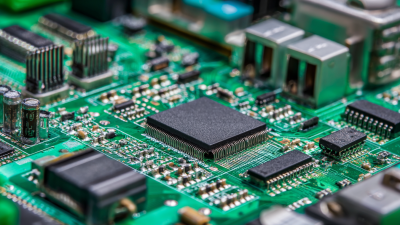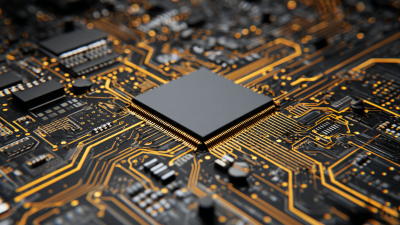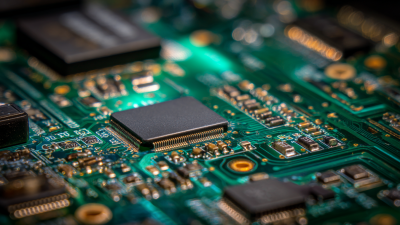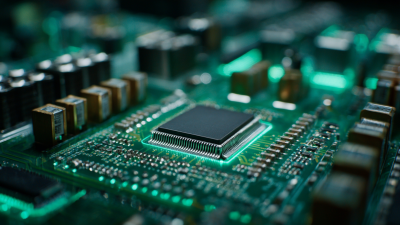
Top 7 Most Innovative Techniques in Circuit Board Production You Need to Know
In the rapidly evolving landscape of electronics, the significance of circuit board production cannot be overstated. As the global electronics market projected to grow to USD 1.93 trillion by 2028, innovations in circuit board manufacturing techniques are becoming pivotal for companies to maintain competitiveness. A recent industry report by Research and Markets indicates that advanced printed circuit board (PCB) technologies contribute significantly to the efficiency, performance, and reliability of electronic devices. These advancements not only optimize production costs but also enhance product quality, which is critical considering the rising consumer demand for sophisticated and miniaturized electronics.
With the increasing complexity of electronic systems being developed for various applications, from smartphones to electric vehicles, manufacturers are compelled to adopt cutting-edge techniques in circuit board production. Techniques such as additive manufacturing, embedded components, and automated inspection systems are at the forefront of this revolution. According to a study by IPC, the global PCB market is expected to witness a compound annual growth rate (CAGR) of 3.5% from 2021 to 2026, driven by these innovations. This article explores the top seven innovative techniques in circuit board production that can help industry players not only meet but exceed customer expectations in this fast-paced environment.
Read more »
 By:Mason - November 24, 2025
By:Mason - November 24, 2025

What is Circuit Board Design and How to Get Started with It
In the ever-evolving realm of technology, circuit board design stands as a cornerstone of innovation, bridging the gap between mechanical and electrical engineering. As the foundation of virtually all electronic devices, from simple gadgets to complex machines, circuit board design is an essential skill that empowers designers to create functional and efficient systems. This introductory guide aims to illuminate the key principles and practices involved in circuit board design, helping aspiring engineers and hobbyists alike gain a solid understanding of this critical area.
As we delve into the intricacies of circuit board design, we will explore the various types of circuit boards, the tools and software used in the design process, and the fundamental concepts that underpin successful board layout and functionality. Whether you are a student looking to enhance your technical skills, a professional seeking to expand your expertise, or simply a tech enthusiast eager to learn more, this guide will provide valuable insights into how to embark on your journey in circuit board design. Join us as we navigate this exciting field and uncover the endless possibilities that await in the world of electronics.
Read more »
 By:Ethan - November 23, 2025
By:Ethan - November 23, 2025

Top 5 Benefits of Using Flex Circuit Boards in Modern Electronics
In the rapidly evolving field of electronics, the integration of innovative technologies has become vital for enhancing performance and functionality. Among these advancements, the flex circuit board has emerged as a game-changer. Dr. Emily Chen, a leading expert in flexible electronics, aptly stated, "Flex circuit boards not only optimize space and weight but also offer unparalleled design flexibility, pushing the boundaries of what electronic devices can achieve." This sentiment reflects the increasing reliance on flex circuit boards in modern applications, where their unique properties significantly contribute to miniaturization and efficiency.
The adoption of flex circuit boards in electronic design is driven by their numerous advantages, including lightweight construction, adaptability to complex shapes, and improved thermal management. As industries shift towards compact and multifunctional devices, these boards are redefining conventional manufacturing processes and enabling innovative solutions across various sectors. Understanding the top benefits of flex circuit boards is essential for engineers and designers alike, as they seek to leverage this technology to meet the demands of contemporary electronics.
Read more »
 By:Ethan - November 21, 2025
By:Ethan - November 21, 2025

Understanding PCB Production: Essential Insights for Future Electronics Innovators
The rapid advancement of technology has positioned PCB production at the forefront of electronics innovation, making it an essential area of study for future innovators. According to a recent industry report by Research and Markets, the global printed circuit board market is projected to reach USD 88.73 billion by 2026, growing at a CAGR of 4.5% from 2021. This growth underscores the increasing demand for sophisticated electronics across various sectors, including automotive, healthcare, and consumer electronics. As such, understanding the intricacies of PCB production is vital for anyone aspiring to contribute to the next wave of technological breakthroughs.
In the pursuit of more efficient designs and manufacturing processes, PCB production has evolved significantly, incorporating advanced materials and innovative techniques. The use of high-density interconnect (HDI) technology, for instance, has become increasingly prevalent, enabling more compact and efficient circuit designs. According to a report from IPC, HDI boards are anticipated to account for over 25% of the total PCB market by 2025, further highlighting the importance of these technologies in modern electronics. By grasping the essential insights into PCB production, aspiring innovators can better position themselves to harness these trends and make meaningful contributions to the field.
Read more »
 By:Ethan - November 19, 2025
By:Ethan - November 19, 2025
Understanding Printed PCBs: How Industry Innovations Drive Performance and Efficiency in Electronics
The evolution of printed PCBs (Printed Circuit Boards) has revolutionized the electronics industry, paving the way for enhanced performance, efficiency, and innovation. As the backbone of modern electronic devices, printed PCBs are pivotal in ensuring that complex circuits are not only compact but also reliable and cost-effective. With advancements in materials, design methodologies, and manufacturing processes, these innovations are enabling engineers to push the limits of electronic capabilities, catering to the ever-growing demands of consumers and industries alike.
In this discussion, we will explore the top ten industry innovations that are driving the performance and efficiency of printed PCBs. These innovations range from the adoption of advanced substrates to the integration of smart technologies, showcasing how the field constantly adapts to meet the challenges of miniaturization and increased functionality. By examining these key developments, we will gain insights into how printed PCBs continue to shape the future of electronics and what this means for upcoming technology trends. This exploration not only highlights the technical aspects but also emphasizes the importance of printed PCBs as a fundamental component in the quest for technological advancement.
Read more »
 By:Ethan - November 19, 2025
By:Ethan - November 19, 2025

Exploring the Future of Electronics: How Flexible Printed Circuit Boards Will Revolutionize device Design in 2024
As we delve into the transformative landscape of electronics in 2024, the emergence of flexible printed circuit boards (FPCBs) is set to redefine device design across various industries. According to a recent report by MarketsandMarkets, the global flexible printed circuit board market is projected to reach USD 27.09 billion by 2026, growing at a CAGR of 10.6% from 2021. This surge in demand is driven by the increasing adoption of compact and lightweight devices in consumer electronics, automotive technology, and wearable gadgets. The versatility of FPCBs allows for innovative designs that not only enhance functionality but also facilitate the integration of advanced features in devices. As we explore the future of electronics, understanding the pivotal role of flexible printed circuit boards becomes essential in predicting industry trends and shaping next-generation product development.
Read more »
 By:Mason - November 14, 2025
By:Mason - November 14, 2025

The Future of PCB Manufacturing Innovations Transforming Electronics Industries
The evolution of PCB manufacturing is at the forefront of transforming the electronics industry, driven by a wave of innovative technologies and methodologies. As highlighted in a recent market report by Research and Markets, the global PCB market is projected to reach USD 83.21 billion by 2026, growing at a CAGR of 3.62% from 2021. This growth is indicative of the escalating demand for advanced printed circuit boards that cater to the ever-increasing complexity of electronic devices, from smartphones to automotive applications. Innovations such as 3D printing, automated manufacturing processes, and the integration of IoT technologies are reshaping how PCBs are designed and produced. Furthermore, a study by Smithers Pira predicts that these innovations will significantly reduce production costs and lead times while enhancing product performance. As the electronics sector continues to advance, embracing these PCB manufacturing innovations is crucial for companies seeking to maintain competitiveness in this rapidly evolving landscape.
Read more »
 By:Ethan - November 13, 2025
By:Ethan - November 13, 2025

Revolutionizing Circuit Board Manufacturing: Innovative Techniques for Efficient Production
The landscape of circuit board manufacturing is undergoing a profound transformation driven by innovative techniques aimed at enhancing production efficiency. According to a recent report by industry research firm Grand View Research, the global printed circuit board (PCB) market size is expected to reach USD 83.5 billion by 2027, growing at a compound annual growth rate (CAGR) of 4.4% from 2020 to 2027. This surge underscores the pressing need for manufacturers to adopt cutting-edge technologies to meet rising demand and improve competitive advantage. Advanced manufacturing processes, such as additive manufacturing and automation, are not just trends; they are essential strategies reshaping the operational landscape. These techniques are proving vital in reducing production times, minimizing waste, and enhancing design flexibility, ultimately leading to significant cost savings. In this context, exploring innovative approaches to circuit board manufacturing is crucial for businesses aiming to thrive in an increasingly competitive market.
Read more »
 By:Ethan - November 11, 2025
By:Ethan - November 11, 2025

Unlocking the Future of Circuit Board Production with Sustainable Practices and Advanced Technologies
As the demand for innovative electronic devices continues to soar, the circuit board production industry faces pressing challenges related to environmental sustainability and efficiency. According to a recent report by MarketsandMarkets, the global printed circuit board (PCB) market is expected to reach USD 89.6 billion by 2025, growing at a CAGR of 4.4%, emphasizing the critical need for sustainable manufacturing practices in this burgeoning sector. Advanced technologies, such as automated assembly processes, IoT integration, and eco-friendly materials, are essential in revolutionizing circuit board production, reducing waste, and lowering carbon footprints. By embracing these sustainable practices, manufacturers can not only meet regulatory demands but also appeal to a growing consumer base increasingly concerned with environmental impacts, ultimately unlocking a more sustainable future for the electronics industry.
Read more »
 By:Lila - November 9, 2025
By:Lila - November 9, 2025

Understanding the Latest Innovations in PCB Manufacturing for Modern Electronics
The rapid evolution of electronic devices has necessitated significant advancements in PCB manufacturing, making it a focal point for innovation in the electronics industry. According to a recent report by Research and Markets, the global PCB market is projected to reach $85.2 billion by 2024, driven by the increasing demand for sophisticated electronic products across various sectors, including automotive, telecommunications, and consumer electronics. In this context, new technologies such as flexible PCBs, high-density interconnect (HDI) designs, and advanced materials are reshaping how manufacturers approach PCB production. These innovations not only enhance performance but also reduce production costs and lead times, fulfilling the stringent requirements of modern electronics. As we delve deeper into the latest trends and technologies in PCB manufacturing, it becomes clear that these developments are pivotal for ensuring the competitiveness and sustainability of electronic products in an ever-evolving market landscape.
Read more »
 By:Lila - November 8, 2025
By:Lila - November 8, 2025

Unlocking Innovation: The Future of Circuit Board Design in 2024 and Beyond
The landscape of circuit board design is poised for significant transformation as we move into 2024 and beyond. According to a recent report by Research and Markets, the global circuit board market is projected to reach $80 billion by 2026, driven by increasing demand in sectors like automotive, consumer electronics, and the burgeoning Internet of Things (IoT). As technology evolves at an unprecedented pace, designers are now leveraging advanced methodologies such as multi-layered designs, flexible circuitry, and computer-aided design (CAD) tools to meet the growing complexity of modern electronics. This shift not only enhances the performance and reliability of circuit boards but also accelerates the innovation cycle, presenting new opportunities for manufacturers and engineers alike. With these developments, understanding the future of circuit board design is crucial for staying competitive in an increasingly dynamic market.
Read more »
 By:Mason - November 7, 2025
By:Mason - November 7, 2025

Understanding the Importance of Flexible Printed Circuits in Modern Electronics
In the rapidly evolving landscape of modern electronics, the significance of flexible printed circuits (FPCs) cannot be overstated. As reported by MarketsandMarkets, the global market for flexible printed circuits is projected to reach $26.73 billion by 2025, growing at a compound annual growth rate (CAGR) of 10.63% from 2020 to 2025. This surge is driven by the increasing demand for compact and lightweight electronic devices across various industries, including consumer electronics, automotive, and medical technology. Flexible printed circuits offer unique advantages such as space efficiency, reduced weight, and enhanced reliability, making them ideal for applications in smartphones, wearables, and advanced medical devices. As manufacturers strive for innovation and improved functionality, understanding the pivotal role of FPCs in enabling design flexibility and performance optimization is essential for stakeholders within the electronics sector.
Read more »
 By:Mason - November 5, 2025
By:Mason - November 5, 2025
